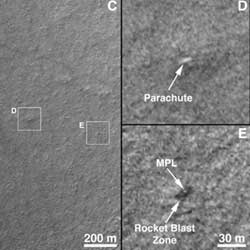
Is this the Mars Polar Lander? Image credit: NASA/JPL. Click to enlarge.
The loss of Mars Polar Lander in December 1999 was a traumatic experience not only for those of us intimately involved in the mission, but also for the U. S. Mars Exploration Program. Following the failure, exhaustive reviews of what happened and why led to major shifts in the way planetary exploration was implemented. Without telemetry, the cause of the failure could only be surmised. It would be extremely important if, through some observation, it were possible to confirm the failure mode.
Shortly after the loss of Mars Polar Lander (MPL), the Mars Global Surveyor MOC was employed to acquire dozens of 1.5 m/pixel images of the landing uncertainty ellipses, looking for any evidence of the lander and its fate. The criteria we used in searching for MPL required a bright feature of irregular or elongated shape (the parachute) within about 1 kilometer (0.62 miles) of a location that included a dark area (rocket-disturbed martian dirt) and a small, bright spot near its center (the lander). In 2000, we found one example (see figure) that met these criteria, but in the absence of any substantive, corroborating evidence, the interpretation that this was MPL and its parachute were considered to be extremely speculative.
Observations by MGS MOC in 2004 of the Mars Exploration Rover (MER) landing sites provided guidance for a re-examination of the previously identified MPL candidate. For example, the material from which the MPL and MER parachutes are made is similar, and its brightness in MOC images can be calculated, at least in a relative sense, as a function of sun angle. The brightness of the candidate “parachute” in the MPL candidate location image turns out to be consistent with it being the same material. The brightness difference of the ground disturbed by rocket blast at the MER sites is similar to the brightness difference seen in the MPL candidate image, again adjusted for the difference in illumination and viewing angles. These consistencies lend credibility to this tentative identification.
If these features really are related to the MPL landing, what can we surmise about that landing from the image? First, we can tell that MPL’s descent proceeded more-or-less successfully through parachute jettison and terminal rocket firing. The relative location of the candidate parachute and lander is consistent with the slight west-to-east wind seen in dust cloud motion in the area around the date of landing. The blast-disturbed area is consistent with the engines continuing to fire until the vehicle was close to the ground. How close is not known. The larger MER retrorockets fired at about 100 m altitude and continued firing until the engines were about 20-25 m above the surface; the candidate MPL disturbance is roughly the same size, but whether this means the engines were firing as close to the ground as the MER rockets cannot be determined. These interpretations are consistent with the proposed MPL mode of failure: the engines fired at the correct time and altitude and continued firing until the flight software checked to see if an electronic message indicated that the landing leg contact switch had been set. Since the initial leg deployment several kilometers above the surface apparently induced sufficient motion to trigger this message, the software stopped the engines as soon as the check was made, about 28-30 seconds into the 36-40 second burn. MPL was probably at an altitude of about 40 m, from which it freely fell. This is equivalent to a fall on Earth from a height of about 40 feet. The observation of a single, small “dot” at the center of the disturbed location would indicate that the vehicle remained more-or-less intact after its fall.
What is important about having a candidate for the Mars Polar Lander site? It gives the MOC team a place to target for a closer look, using the compensated pitch and roll technique known as “cPROTO.” Examples of cPROTO images and a description of this capability, developed by the MGS team in 2003 and 2004, were discussed in a MOC release on 27 September 2004. Without a candidate for targeting a cPROTO image, it would take more than 60 Earth years to cover the entire Mars Polar Lander landing ellipse with cPROTO images, because the region spends the better part of each Mars year covered with carbon dioxide frost, part of each winter is spent in darkness, and, because of several uncertainties involved with the technique, it often takes two, three, or more tries before a cPROTO image hits a specific target. Now that a candidate site for Mars Polar Lander has been identified, we have a cPROTO target, which may permit us to obtain an image of about 0.5 meters per pixel (allowing objects approximately 1.5-2.5 meters in size to be resolved) during southern summer this year. At the present time (May 2005), the landing site is just beginning to lose its cover of seasonal carbon dioxide frost.
Original Source: Malin News Release
